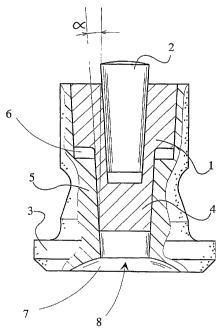Some of the information on this Web page has been provided by external sources. The Government of Canada is not responsible for the accuracy, reliability or currency of the information supplied by external sources. Users wishing to rely upon this information should consult directly with the source of the information. Content provided by external sources is not subject to official languages, privacy and accessibility requirements.
Any discrepancies in the text and image of the Claims and Abstract are due to differing posting times. Text of the Claims and Abstract are posted:
| (12) Patent: | (11) CA 2440090 |
|---|---|
| (54) English Title: | STUD FOR A TYRE |
| (54) French Title: | CLOU POUR PNEU A CLOUS |
| Status: | Deemed expired |
| (51) International Patent Classification (IPC): |
|
|---|---|
| (72) Inventors : |
|
| (73) Owners : |
|
| (71) Applicants : |
|
| (74) Agent: | MARKS & CLERK |
| (74) Associate agent: | |
| (45) Issued: | 2010-06-22 |
| (86) PCT Filing Date: | 2002-03-07 |
| (87) Open to Public Inspection: | 2002-09-12 |
| Examination requested: | 2007-03-06 |
| Availability of licence: | Yes |
| (25) Language of filing: | English |
| Patent Cooperation Treaty (PCT): | Yes |
|---|---|
| (86) PCT Filing Number: | PCT/FI2002/000176 |
| (87) International Publication Number: | WO2002/070287 |
| (85) National Entry: | 2003-09-05 |
| (30) Application Priority Data: | ||||||
|---|---|---|---|---|---|---|
|
The invention relates to a stud for a tyre comprising a socket-formed body
portion (1), having at one end a hard metal peak (2) and at its other end a
locking flange (3) retaining the stud in the tyre and being made of a light
injection-mouldable material, such as plastic, the body portion (1) having a
pin (4) extending towards the locking flange, with the tubular sleeve portion
(5) of the locking flange fixed on top of this pin. The body portion (1) is
conical so as to be clamped as a wedge into the corresponding conical sleeve
portion (5).
La présente invention concerne un clou pour pneu à clous. Ce clou est constitué d'un corps en douille (1) dont une extrémité est pourvue d'une pointe en métal dur (2), l'autre extrémité constituant une flasque d'arrêt (3) bloquant le clou dans le pneu et faite d'un matériau léger se moulant par injection, tel que du plastique. Le corps (1) comporte une broche (4) orientée vers la flasque d'arrêt, la partie constituant le manchon tubulaire (5) de la flasque d'arrêt étant fixée au sommet de cette broche. Le corps (1) est conique de façon à être pris en pince comme un coin dans la partie correspondante en manchon conique (5).
Note: Claims are shown in the official language in which they were submitted.
Note: Descriptions are shown in the official language in which they were submitted.

For a clearer understanding of the status of the application/patent presented on this page, the site Disclaimer , as well as the definitions for Patent , Administrative Status , Maintenance Fee and Payment History should be consulted.
| Title | Date |
|---|---|
| Forecasted Issue Date | 2010-06-22 |
| (86) PCT Filing Date | 2002-03-07 |
| (87) PCT Publication Date | 2002-09-12 |
| (85) National Entry | 2003-09-05 |
| Examination Requested | 2007-03-06 |
| (45) Issued | 2010-06-22 |
| Deemed Expired | 2013-03-07 |
There is no abandonment history.
| Fee Type | Anniversary Year | Due Date | Amount Paid | Paid Date |
|---|---|---|---|---|
| Application Fee | $150.00 | 2003-09-05 | ||
| Maintenance Fee - Application - New Act | 2 | 2004-03-08 | $50.00 | 2003-09-05 |
| Registration of a document - section 124 | $100.00 | 2004-03-31 | ||
| Maintenance Fee - Application - New Act | 3 | 2005-03-07 | $50.00 | 2005-02-18 |
| Maintenance Fee - Application - New Act | 4 | 2006-03-07 | $50.00 | 2006-02-17 |
| Maintenance Fee - Application - New Act | 5 | 2007-03-07 | $100.00 | 2007-03-05 |
| Request for Examination | $400.00 | 2007-03-06 | ||
| Maintenance Fee - Application - New Act | 6 | 2008-03-07 | $100.00 | 2008-02-20 |
| Maintenance Fee - Application - New Act | 7 | 2009-03-09 | $100.00 | 2009-02-24 |
| Maintenance Fee - Application - New Act | 8 | 2010-03-08 | $100.00 | 2010-02-18 |
| Final Fee | $300.00 | 2010-04-09 | ||
| Maintenance Fee - Patent - New Act | 9 | 2011-03-07 | $100.00 | 2011-02-16 |
Note: Records showing the ownership history in alphabetical order.
| Current Owners on Record |
|---|
| TURVANASTA DEVELOPMENT OY |
| Past Owners on Record |
|---|
| SALAKARI, HEIKKI |